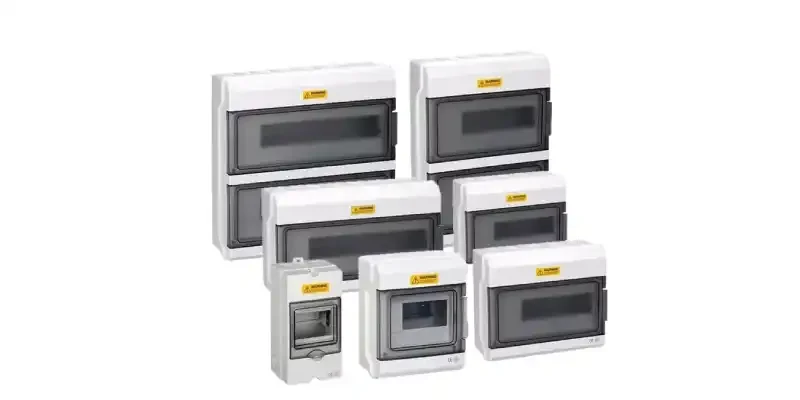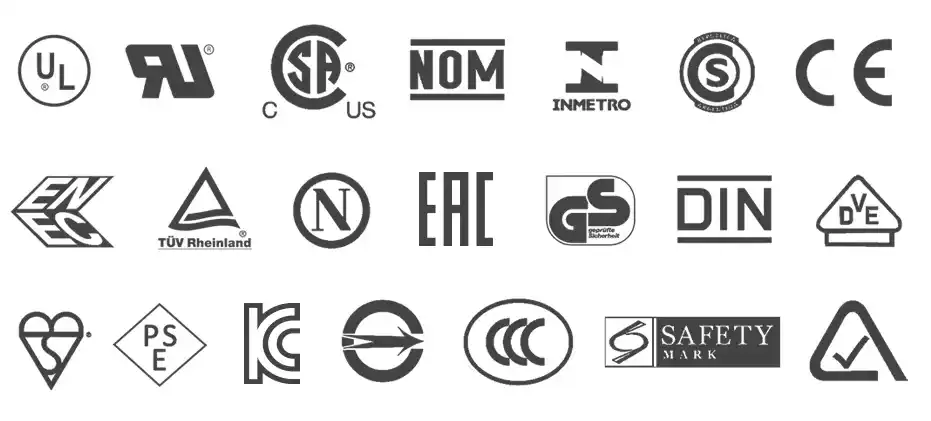Průvodce výběrem distribučního boxu
Tato příručka poskytuje informace o tom, jak vybrat vhodný rozváděč pro elektrický projekt. Máte-li jakékoli dotazy týkající se rozvodných skříní, neváhejte se na nás obrátit.
Co je potřeba pro distribuční box
A rozvodná skříň, někdy označované jako panelová deska, rozvodná deska, nebo panel jističů, je nezbytnou součástí elektrických systémů, která usnadňuje rozvod elektřiny po celé stavbě. Rozdělení přívodu elektrické energie z hlavního přívodu do vedlejších obvodů je hlavním účelem rozváděče. Obsahuje řadu bezpečnostních mechanismů, mezi něž patří např. pojistky a jističe, které pomáhají předcházet přetížení a zkratům. Toto elektrické rozvodné centrum zajišťuje bezpečné připojení zásuvek a osvětlení na různých místech.
Součásti rozváděče
Pro řízení a rozdělování elektrické energie uvnitř objektu je nezbytný rozváděč - označovaný také jako jističový panel nebo elektrický rozváděč. Funguje jako primární rozbočovač, přes který je několik obvodů připojeno k hlavnímu přívodu elektřiny. Následují hlavní prvky rozváděče:
1. Autobusové tyče
Rozvody energie v rámci panelu jsou autobusové tyče, což jsou vodivé kovové pásky složené obvykle z mědi nebo hliníku. Vytvářejí spojení mezi hlavním jističem a několika odbočujícími obvody a slouží jako základ rozváděče.
2. Jističe
Jističjsou důležité bezpečnostní prvky, které chrání elektrické obvody před přetížením a zkratem. Když jimi prochází nadměrné množství proudu, okamžitě přeruší přívod energie, aby se zabránilo možnému poškození elektrického systému. V závislosti na potřebě mohou být jističe jednopólové nebo dvoupólové.
3. Zbytkové proudové chrániče (RCD)
Přístroje RCD sledují tok elektrického proudu v obvodu a přeruší jej, pokud zaznamenají nerovnováhu, která by mohla být známkou úniku proudu. V domácích i komerčních instalacích je tato funkce nezbytná pro prevenci úrazu elektrickým proudem a zajištění bezpečnosti.
4. Pojistky
Pojistky jsou bezpečnostní zařízení, která přerušují obvod, pokud jimi prochází nadměrné množství proudu. Pokud se pojistka přepálí, je třeba ji na rozdíl od jističů vyměnit. I když se v současných rozváděčích vyskytují méně často, přesto se používají v několika situacích.
5. Zařízení na ochranu proti přepětí (SPD)
SPD chránit před přepětím nebo napěťovými špičkami způsobenými bleskem, které by mohly poškodit elektrická zařízení. Pomáhají zabránit poškození citlivé elektroniky připojené k rozvodné desce.
6. Hlavní jistič
Hlavní jistič slouží jako hlavní bezpečnostní zařízení elektrického systému. V případě přetížení nebo poruchy přeruší napájení všech propojených obvodů odpojením hlavního přívodu.
7. Izolátory a odpojovače
Tyto spínače zajišťují bezpečné odpojení obvodů pro nouzové situace nebo údržbu. Zaručují, že odpojení některých částí elektrického systému od napětí nepoškodí jiné.
8. Neutrální a zemnicí tyče
Díky specifickému připojení nulového a zemnicího vodiče jsou tyto vodiče bary zaručit, že elektrické proudy v systému jsou řádně uzemněny a mají zpětné cesty.
9. Obtokové zařízení
Obtokové zařízení umožňuje testování nebo opravu obvodů bez ovlivnění ostatních součástí elektrického systému.
Jak vybrat správný elektrický rozvaděč pro domácnost?
Zhodnoťte své elektrické potřeby
Začněte tím, že pečlivě vyhodnotíte elektrické potřeby své nemovitosti. Proveďte důkladný soupis všech spotřebičů, svítidel a přístrojů, které budou připojeny k desce DB. Nezapomeňte zohlednit možné budoucí doplňky, abyste nepodcenili své požadavky. Zvažte budoucí konfigurace domácí kanceláře, nová zařízení a chystané rekonstrukce, které by mohly zvýšit spotřebu elektrické energie.
Poraďte se s profesionálním elektrikářem
Najměte si co nejdříve elektrikáře s licencí. Pokud jde o výběr správné velikosti a konfigurace desky DB, jsou jeho znalosti zásadní. Jsou schopni zaručit dodržení všech příslušných bezpečnostních předpisů a provést přesné výpočty zatížení. Řídíte-li se radami elektrikáře, můžete zajistit, aby byl váš elektrický systém bezpečný a účinný, a vyhnout se tak drahým chybám.
Výzkum různých značek a modelů
Prozkoumejte mnoho modelů a značek, které jsou na trhu. Prozkoumejte zpětnou vazbu od uživatelů a specifikace a vyberte si desku DB, která bude vyhovovat vašim potřebám. Několik věcí, na které je třeba se zaměřit, je kvalita provedení, jednoduchost instalace a pomoc po nákupu. Na adrese VIOX Electric, nabízíme výběr prvotřídních desek DB, které jsou ideální pro řadu domácích aplikací a jsou vyrobeny podle nejvyšších bezpečnostních požadavků.
Zvažte svůj rozpočet
Náklady je třeba brát v úvahu, ale mějte na paměti, že váš elektrický rozvaděč je dlouhodobou investicí, která zlepší funkčnost a bezpečnost vašeho domu. Snažte se o rovnováhu mezi kvalitou a cenou. Kromě pořizovací ceny berte v úvahu i dlouhodobé aspekty, jako je energetická účinnost a potřeby údržby. Někdy se stává, že počáteční výdaj více peněz za kvalitnější rozvaděč může v průběhu času ušetřit peníze tím, že zvýší účinnost a bude vyžadovat méně údržby. účinnost a výkon.
Instalace a testování
Ujistěte se, že vámi vybranou desku DB instaluje elektrikář s licencí. Odborná instalace je nezbytná pro účinnost i bezpečnost. Pro zajištění správné funkce by měl být dodržen důkladný zkušební postup, který by měl zahrnovat kontrolu rozložení zátěže, činnosti jističů a uzemnění. Po instalaci naplánujte běžné kontroly údržby, abyste rozváděč udrželi ve výborné kondici a včas odhalili případné problémy.
Faktory, které je třeba zvážit při výběru distribučního boxu
Typ nemovitosti
Při určování vhodného distribučního boxu hraje zásadní roli charakter vašeho majetku. Různá prostředí mají odlišné požadavky na elektrickou energii:
- Rezidenční: Domy obvykle vyžadují jednofázové napájení a rozvodnou skříň s menším počtem okruhů. Tyto krabice jsou kompaktní a vhodné pro správu domácích spotřebičů a osvětlení.
- Komerční: Obchodní prostory často potřebují třífázové napájení a složitější rozvodné skříně. Ty mohou zpracovávat větší počet obvodů a větší elektrické zatížení, které je určeno pro zařízení, osvětlení a systémy HVAC.
Počet obvodů
Pečlivě zhodnoťte počet okruhů, které vaše nemovitost potřebuje. To zahrnuje:
- Světelné obvody
- Energetické body
- Systémy HVAC
- Specializované obvody pro velké spotřebiče nebo stroje
Nezapomeňte plánovat nejen pro současné potřeby, ale také pro případné budoucí rozšíření. Často je cenově výhodnější nainstalovat zpočátku o něco větší skříň než později upgradovat.
Kapacita zatížení
Při návrhu nebo modernizaci bytového rozváděče je nezbytné přesně vypočítat celkové elektrické zatížení. Tím zajistíte, že rozváděč bezpečně zvládne kombinované zatížení všech připojených obvodů. Zde je typický příklad výpočtu zátěže pro dům o rozloze 1 500 čtverečních stop:
Výpočet začíná výčtem hlavních elektrických prvků v domě, včetně celkového osvětlení a zásuvek, obvodů pro malé spotřebiče, okruhu prádelny, plynové pece, mikrovlnné trouby a nového elektrického ohřívače vody. Pro každou položku se odhadne a uvede spotřeba energie (VA).
| Všeobecné osvětlení a zásuvky: 1 500 čtverečních stop domu x 3 VA na čtvereční stopu. | 4 500 VA |
| Obvody pro malé spotřebiče: 2 obvody x 1 500 VA | 3 000 VA |
| Prací okruh: 1 okruh x 1 500 VA | 1 500 VA |
| Plynová kamna: 1 okruh x 1 500 VA | 1 500 VA |
| Mikrovlnná trouba: 1 okruh x 1 500 VA | 1 500 VA |
| Nový elektrický ohřívač vody: 1 okruh x 3 000 VA | 3 000 VA |
| Mezisoučet Stávající zatížení | 15 000 VA |
| Prvních 8 000 VA stávajícího zatížení při 100% | 8 000 VA |
| Zbývající stávající zatížení na 40% (15 000 VA - 8 000 VA = 7 000 VA) (7 000 VA x 40% = 2 800 VA) | 2 800 VA |
| Celková stávající zátěž | 10 800 VA |
| Přepočítejte 10 800 VA na ampéry (10 800 VA děleno 240 V = 45 A) Pro tento dům je více než dostačující 100ampérová služba. | |
Family Handyman - Výpočet elektrického zatížení
Bezpečnostní prvky
Moderní desky DB jsou vybaveny různými bezpečnostními prvky, jako jsou proudové chrániče (RCD), přepěťové ochrany (SPD) a miniaturní jističe (MCB). Tyto funkce chrání před úrazem elektrickým proudem, přepětím a zkratem.
- Přístroje RCD: Detekují a odpojují napájení v případě zemního spojení.
- SPD: Chrání před napěťovými špičkami způsobenými bleskem nebo přepětím.
- MCB: MCB: Automaticky odpojí napájení při přetížení nebo zkratu.
Soulad s normami
Ujistěte se, že vybraný distribuční box splňuje místní a mezinárodní bezpečnostní normy. Například v Jihoafrické republice je dodržování směrnic SANS (South African National Standards) povinné. Tato shoda zajišťuje, že box splňuje minimální bezpečnostní a výkonnostní požadavky.
Snadná instalace a údržba
Vyberte si rozváděč určený pro jednoduchou instalaci a údržbu:
- Hledejte modulární konstrukce, které umožňují snadné rozšíření
- Vyberte si krabice s jasným označením pro rychlou identifikaci obvodů.
- Zvažte dostupnost pro budoucí opravy nebo modernizace.
Průvodce instalací
Pro ty, kteří chtějí instalovat rozvaděč nebo zapojit jednofázový dům, jsme připravili dvě instruktážní videa, která vás tímto procesem provedou:
- Jak instalovat rozvodnici na stěnu
V tomto videu je krok za krokem popsána správná montáž rozvodnice na stěnu. Zahrnuje základní aspekty, jako je výběr správného umístění, zajištění desky a zajištění její rovnosti a stability.
- Jak zapojit jednofázové schéma zapojení domu
Tento návod vás provede procesem zapojení jednofázového domu. Vysvětluje schéma zapojení a ukazuje, jak zapojit různé obvody a komponenty v obytném elektrickém systému.
Závěr
Výběr správného rozváděče má zásadní význam pro zajištění bezpečnosti, účinnosti a spolehlivosti vašeho elektrického systému. Zvážíte-li faktory, jako je typ vašeho objektu, počet potřebných obvodů, zatížitelnost, bezpečnostní prvky a soulad s normami, můžete se rozhodnout na základě informací. Nezapomeňte se poradit s profesionálním elektrikářem, naplánovat budoucí potřeby a upřednostnit kvalitu a bezpečnost před náklady. Správná instalace a pravidelná údržba jsou stejně důležité pro maximalizaci životnosti a výkonnosti rozváděče. Po pečlivém zvážení a odborném vedení můžete vytvořit elektrický systém, který bude vyhovovat vašim současným potřebám a bude připraven na budoucí požadavky.




